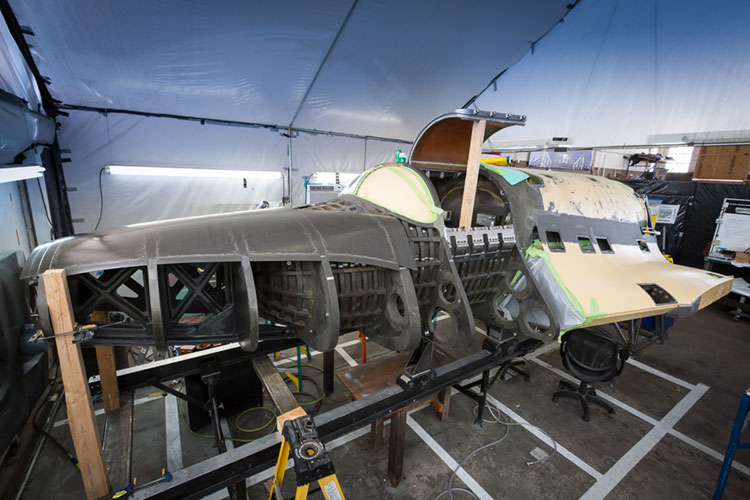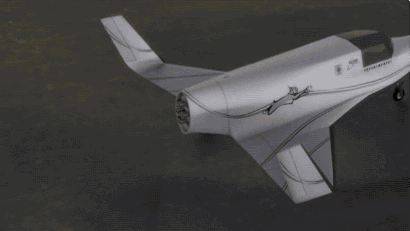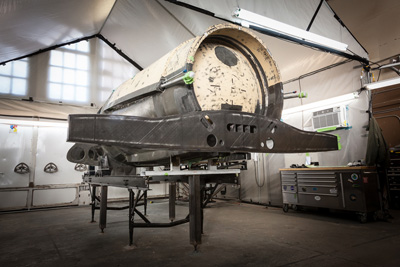
XCOR Aerospace proudly announced continued progress on its Lynx spaceplane, a suborbital spacecraft designed to take humans and payloads to the edge of space. The Lynx strakes, a major portion of the Lynx aerodynamic shell, were successfully bonded to the fuselage of the Lynx Mark I spacecraft on April 30, marking a major milestone for the company as they can now begin the electric wiring and installing process on the Lynx reusable launch vehicle (RLV).
The Lynx is the company’s two-seat, piloted space transport vehicle and its entry into the competitive commercial RLV market. Lynx will take off and land horizontally, like an aircraft, but instead of a jet or piston engine the Lynx will use its own reusable rocket propulsion system of four XR-5K18 engines to safely depart and return on a runway. The vehicle will take humans and payloads on a 30-minute journey to the edge of space, topping out at 330,000 feet (100 km).

The first XCOR Lynx suborbital vehicle is currently undergoing production at XCOR Aerospace Hangar 61 in Mojave, Calif. The 10,375-square-foot hangar houses their team of more than fifty skilled employees at the Mojave Air and Space Port. Rapid development on the Lynx Mark I spacecraft means that the company is coming closer and closer to Lynx full assembly and first flight. The vehicle will take a pilot and a participant to the edge of space and provide inexpensive suborbital launch services to numerous markets. The Lynx Mark I is the company’s initial flight test vehicle and is expected to begin a flight test program later this year.
The integration of the strakes to the Lynx Mark I spacecraft marks a big step toward final vehicle assembly for the growing aerospace company.
“Today marks another solid milestone in our progress toward first flight, clearing the path for a series of important moments that will accelerate Lynx development,” said XCOR President and Chief Executive Officer Jay Gibson.
Each strake is subdivided into four separate fuel tanks. They are pressurized during flight and provide the engines with a combustible hydrocarbon liquid used in jet engines called kerosene. Two reaction control thrusters and a main landing gear assembly are stored inside each strake. The lynx will use the reaction control thrusters while it is out of the atmosphere and making altitude changes.
Now that the strakes are successfully bonded to the vehicle, Chief Technology Officer Jeff Greason described the next steps for Lynx development: “We have an open path toward the integration of a number of subsystems, and this means we will now start electrical wiring, plumbing, installing the control system, and populating the landing gear bays.”
Last December, just five months ago, XCOR reached a significant milestone after it bonded the cockpit and the carry-through spar on to the back end of the Lynx fuselage. This crucial step had to be completed before the strakes were to be attached.
In order to carefully place the spar, the Lynx rocket truss was removed from its test stand and placed on the vehicle. Composite technicians worked tirelessly to perfectly align the spar and bond it in place.
“The carry-through spar is the heart of the loading structure on any winged craft – it supports the primary load of the wings and carries that load through the fuselage,” explained Jeff Greason. “Attaching the spar on a composite vehicle is a one-way operation, so it has to be done right the first time.”

The entire structure was put under a pressure test after the spar was successfully installed. It experienced pressure equivalent to a 6 g re-entry with the cabin pressured to 11 PSI.
The XCOR Lynx RLV is unique in many aspects. Unlike vertical rocket launches and air-launched rocket vehicles, the aircraft-like abilities allow for much more flexibility and re-use. The Lynx will provide up to four flights per day from a licensed spaceport with a 2,400-meter (7,900-ft) runway. It will have a quick turnaround of just two hours and go on 40 flights before needing routine maintenance. It will be affordable to operate and maintain and be heavily focused on providing safe and reliable flights to space.
An all-composite airframe makes the Lynx lightweight and incredibly sturdy. It is able to withstand the fiery re-entry from space because it is protected by a thermal protection system (TPS) on its nose and leading edges. Its wing area is structured for landing at average speeds around 90 knots. The entire spacecraft measures to be about 9 meters (~30 ft) in length with a double-delta wing, stretching out to a wide 7.5 meters (~24 ft) in length.
XCOR has several models of Lynx production vehicles that each serves a particular set of needs and/or markets.
The Lynx Mark I, as described above, is the prototype test vehicle currently under development at XCOR Aerospace Hangar 61. It will be used to test the various sub-systems within the aircraft such as structure, aeroshell, tanks, life support, propulsion, aerodynamics, and re-entry heating. It is designed to reach an altitude of 200,000 feet (~61 km). Eventually Lynx Mark I will be used to train pilots and crew for the Lynx Mark II.
The Lynx Mark II is designed to service both the space tourism market and markets that will utilize the payload capacity for microgravity research and experiments. The Mark II uses the same propulsion and avionics systems as its predecessor (Mark I) but give higher performance because of its lower dry weight. This vehicle has a lightweight composite LOX tank and other key components that are exclusive to the company. It is designed to fly up to 328,000 feet (~100 km) and take payloads and participants on suborbital trips to the edge of space.
Passengers can hitch an out-of-this-world experience aboard the Lynx for $95,000 a flight. Prior to the flight, participants will go through medical screenings, seminars, and g-force training to familiarize them with the suborbital spaceflight experience. The participant will sit to the right of the pilot inside the pressurized cabin and wear a pressure suit for added safety. Pilot and passenger will take off from a runway into the black sky. They will view the curvature of Earth and enjoy about 4.6 minutes in microgravity at apogee (328,000 ft). The spaceplane will then descend to lower altitudes and land on the same runway it took off from.
https://youtu.be/4yaNvBecEac
Video Credit: XCOR Aerospace
The Lynx Mark III is a more advanced version of the Mark II. It comes with the capability to carry an external dorsal pod with a total payload capacity of 650kg. The pod can host either a payload research experiment or an upper stage to launch a satellite into low earth orbit (LEO). The Mark III encompasses upgraded landing gear, aerodynamics, core structural improvements, and more, over the Mark II. The Lynx Mark III features a power-packed propulsion package to transport heavier payloads into space.
Four XR-5K18 rocket engines will power XCOR’s Lynx launch vehicles, each producing 12.9 kN (2900 lbf) thrust by burning a concoction of liquid oxygen and kerosene. The first hot fire of this rocket engine was in December 2008 and continues to be tested today.
XCOR is currently building a Research and Development Center in Midland, Texas, at Midland International Airport. The aerospace company plans on opening an operational and manufacturing site at NASA’s Kennedy Space Center in Florida, with the aid of Space Florida.
Be sure to “Like” AmericaSpace on Facebook and follow us on Twitter: @AmericaSpace




This is part of the emerging future as I see it. Mostly cash flow and incremental development. Very little hype if any. Rapid turnaround designed in. If it works as planned, then there will be a team that knows how to build a high flight rate first stage. If that can be cash flowed, it will be a real game changer.
Disclosure is that I have friends in the company and have done business with them.
Hi John,
I have a hard time picturing the vehicles described scaling to produce the kind of payloads in which I am interested, but as per our previous discussion it is not “my” money; so I wish them and you luck.
Do you know what fuel they intend to use for their RCS System?
I’m pretty sure it won’t scale up to the sizes of interest to you. The idea is fast turnaround of small loads. Amortize the development and vehicle cost over hundreds of flights per airframe and the payloads don’t have to be large or expensive to make a profit. I know you’ve heard all this before, so I’ll quit now.
I haven’t been even vaguely current with them since the economy tanked. I’ll offer 5 to 1 that the RCS is non toxic though, even without making a phone call. Among other things, I’ve watched them fire the 15 lb nitrous/propane “teacart” engine a dozen or more times in a conference hall during a single session. That was about 2002 or so.
XCOR is possibly the best chance I’ll have of seeing one of my concepts in use. I put a number of them in the public domain a few years ago and hopefully will get bragging rights at some point. One of them was a compensating nozzle that should be simple and cheap. Crossing fingers that they do, and it is close enough to the original that I can feel that I made a contribution to the industry, however small.
A manned flight to take payload up is just a waste of up-mass. And I can’t imagine a one pilot, one passenger per flight is ever profitable, when the passenger is buckled in and can’t float around in 0g. Floating in 0g while looking at the blue ball IS the public perception of going to space. It doesn’t matter how high above the Karmen line you go, or how many of those Made in China astronaut pins you pass out.
Rich folks go to VG partly to network with other successful businessmen, I don’t know why they want to meet that lowly employee of a pilot like everyone else does… This is just a bad biz plan from the gecko.
Do the math first. If they can hit their 4 flights per day target, then the gross would be $95M per year per airframe. Even at Mig25 ride prices of $15K per flight, gross would be $15M per year per airframe and not having to go to Russia for the adventure will make quite a difference.
It’s not your plan or your money, so if it’s bad, it’s their problem, not yours. Many people don’t get the idea of incremental steps. Don’t buy into the idea that the way to promote ocean travel is to burn the fishing fleets and harbor craft.
4 flights per day? That’s awesome. Did you worked on the Space Shuttles back in the days as well?
4 suborbital flights per day is their target. They have done two other rocket vehicles in the past that were able to gas-n-go. The EZ-Rocket was a demonstrator with rockets in a Long Easy. The rocket racer was based on a Velocity aircraft as I recall and had turnaround times in the single digit minutes.
There’s no servicing and stacking here. 30 minute flight, swap passenger while refueling, then another flight. For the rocket portion, this will be the third time they have done this. The airframe is the hairy deal for them.
The eventual orbital payloads would be launched with expendable from the dorsal pod at Mach 3 and well over 100,000 feet with low dynamic pressures. Last I read was that a 25 kg payload was conservative estimate based on their prior experience. I have talked to researchers that would pay $1M for this type launch and consider it a bargain. It is the ability to fly on demand that interests people doing materials, pharmaceutical or biological research. Fly, evaluate, change out some parameters and fly again in a week or month when ready allows serious work. I don’t know the projected turnaround time when stacking for orbital pods.
XCOR has nothing to do with SpaceX and Elon Musk. They do hydrogen pump work for ULA that I know of. Yes the Shuttle was overpromised to the point of malfeasance, so I did get a chuckle from your little shot.
Going from absolute ZERO flights in 11 years is a long an windy road….
Good points all, John.
Just part of the carnival sideshow that is NewSpace that this worthless junk is taking up space in a blog about space exploration. Disgusting. The space clown wannabe’s rambling on about profit margins and price points and how this is going to enable Beyond Earth Orbit – Human Space Flight are so completely deluded it is amazing. Like canoeing in a duck pond and believing you are crossing the pacific.
The worst part of course is the public being mislead; they have very little knowledge of basic spaceflight principles to start with and do not know any better than to believe all the hype. NewSpace has done so much damage to space exploration in the last five years it is nauseating. I despise all of these DIY Ayn-Rand-in-Space bizarro fools who are cheering on the scam that if unchecked will strand us in Low Earth Orbit for the next 40 years.
All I can hope for is the fall of Musk and the resulting fallout from that inevitable house of cards falling apart will improve the situation. Remove NASA support from the hobby rocket empire and the whole rotten facade will fall apart.
Musk may have the credential,financial network, and charisma to pull this off, I think he got enough momentum to keep it going. Can’t say that about the certain middle managers from Intel. 😀
The satellite market is so small and SpaceX relies on NASA and taxpayer dollars to such an extant that whether it can survive on it’s own two feet as a commercial launch provider is actually not clear at all. This is because all these other countries mostly use their own domestic launchers. What is left? This is why Musk is gunning for DOD dollars but he is in for a surprise about how that works. All of what I just stated was discussed or nodded and winked at during the recent defense hearings on assured access to space- if you care to listen to it like I did. Everyone certainly thinks SpaceX is this free market miracle provider but that is the miracle of P.R.- class action labor lawsuits are a clue that all is not well in the hobby rocket empire. One thing though is absolutely certain- tourism is a dead end. How it keeps getting hyped as this great new “industry” is proof of the old saying-“there’s a sucker born every minute.”
Someone sounds bitter…
I agree with ya, any launch provider will need government funding in one form or the other. And with the money NASA and Air Force put into SpaceX, I think they have an interest to keep it afloat as well,and they do provide a less $$ product(for now).
Musk won’t pull this off at all. Neither he or SpaceX has anything to do with XCor and the Lynx.
XCor is hoping to work the sub-orbital tourism market and make money as a contractor for NASA flying sub-orbital experiments. They have an agreement in place with NASA for brokering up to $10 million dollars in sub-orbital flight services.
There are no “sub-orbital flight services” or “sub-orbital experiments” worth doing. An agreement for 10 million dollars? That won’t even pay for the insurance.
Why would anyone want to pay $95,000 to fly in a shoe-box sized cockpit to experience 0-g and not be able to float around?
I guess the people that have already put up deposited would have to answer that. To me, it’s right up there with four hundred thousand dollar cars and spectator sports being a trillion dollar industry.
Car…I can drive. Would Xcore let me fly? Car, I can show off to chicks… I have to drag a girl to Mohave desert or worst…Midland, TX to show off….
No picture of selfies with the rich-n-famous, just a picture with an unknown pilot with an stamp-in-Taiwan astronaut pin.
So you’re not part of their market. That’s cool.
And “suborbital”? It’s a joke. I ain’t space. Should not even be mentioned as “space.” It’s bad enough that going in circles at very high altitude is masquerading as actually going somewhere. Space “travel” requires a destination.
http://time.com/3857549/sarah-brightman-international-space-station/
Someone else just figured out it’s B.S. also.
X-Cor seems like a big joke and tax write off for someone! All these years and not one flight? Really X-Cor show us a flight, and I may change my mind. Your launch vehicle concept is doomed from the design up. It may do high atmosphere but never will it make a low orbit or even an arch to anything approaching what you claim! Will it work in Kerbal Space Program? NO! LOL
Stop wasting our time!